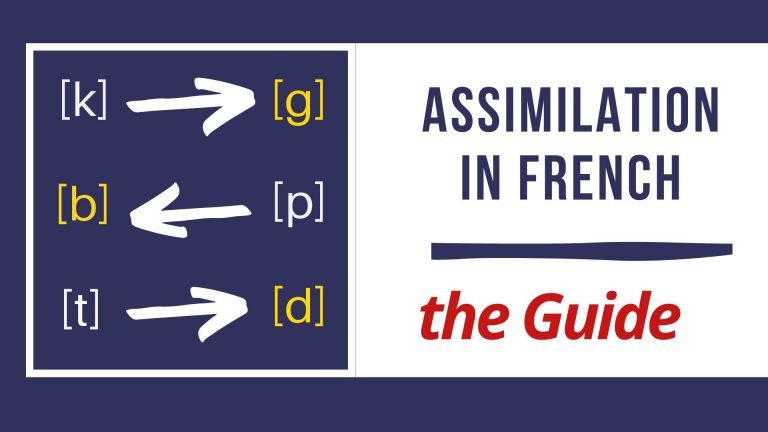Everything to know about phonological assimilation in French
Updated: 2 April, 2023 by Mylene in Pronunciation Lessons ▪

Consonants sounds can change depending on their environment. The changes affect the tone character of their pronunciation. Sound assimilation is a phenomenon that happens when sound is mixed with other sounds. Below, you will find out in which case a sound assimilation occurs.
- Why does assimilation happen?
- The case where the letter e is silent.
- What are the pairs of voiced and unvoiced consonants?
- The pair [t]/[d]
- The pair [s]/[z]
- The pair [f]/[v]
- The pair [ʃ]/[ʒ]
- The pair [p]/[b]
- The pair [k]/[g]
What is sound assimilation in linguistics?
Why does assimilation happen?
When a voiceless consonant is next to a voiced one, voice assimilation can occur. Assimilation is a natural thing. For example, in the word “absent”, it is easier to pronounce the sound [p] than to pronounce the sound [b]. Assimilation then happens. The unvoiced consonant [s] affects the pronunciation of the voiced consonant [b]. The voiced consonant [b] loses its voice and is pronounced [p].
- absent is pronounced [apsɑ̃].
Similarly,
- absurde is pronounced [apsyʁd].
- observe is pronounced [ɔpsɛʁve].
What is an unvoiced consonant?
Unvoiced consonants are consonants that do not require the use of vocal cords to produce a sound.
What are the non-voiced consonants?
The six non-voiced consonants are: [t], [s], [f], [ʃ], [p] and [k].
What is a voiced consonant?
A voiced consonant is a consonant that requires the use of the vocal cords to produce a sound.
What are the voiced consonants?
The 6 consonants that make a sound are: [d], [z], [v], [ʒ], [b] and [g].
You find detailed information about the spelling of the consonants of the Phonetic Alphabet.
The case where the letter e is silent
The mute e, sound [ə], can disappear when there is a single consonant pronounced in front. Deleting this silent e will allow 2 consonants to be side by side. To learn more about the pronunciation of silent e, you can read the rules when it comes to pronouncing the mute E in French.
- In the word “médecin”, the mute e is not pronounced because there is only one consonant pronounced in front, the sound [d],
- The unvoiced consonant [s] will affect the pronunciation of the voiced consonant [d],
- The consonant [d] loses its voice and is pronounced [t].
- médecin is pronounced [mɛtsɛ̃]
Get some help
Practicing assimilation alone can be difficult, which is why I suggest accompanying you. You can join the coaching program.
What are the unvoiced consonant / voiced consonant pairs?
There are 6 unvoiced consonant / voiced consonant pairs:
- The pair [t]/[d]
- The pair [s]/[z]
- The pair [f]/[v]
- The pair [ʃ]/[ʒ]
- The pair [p]/[b]
- The pair [k]/[g]
The pair [t]/[d]
Assimilation allows the unvoiced consonant [t] to gain its voice and be pronounced [d]. On the other hand, the voiced consonant [d] may lose its voice and become pronounced [t]. Below are two examples.
- In the word “au-dessus“, the silent e is not pronounced because there is only one consonant pronounced in front, the [d].
- The unvoiced consonant [s] is therefore next to the voiced consonant [d],
- The unvoiced consonant [s] will affect the pronunciation of the voiced consonant [d],
- The consonant [d] loses its voice and is pronounced [t],
- “au-dessus” is pronounced [otsy].
trente-deux
- The voiced consonant [d] will affect the pronunciation of the unvoiced consonant [t],
- The consonant [t] earns its voice and is pronounced [d],
- We must pronounce a sound [d] a little louder than usual,
- trente-deux is pronounced [tʁɑ̃d:ø].
The pair [s]/[z]
Assimilation allows the unvoiced consonant [s] to gain its voice and be pronounced [z]. On the other hand, the voiced consonant [z] may lose its voice and become pronounced [s]. Below are two examples.
Plus d’eau
- The voiced consonant [d] will affect the pronunciation of the unvoiced consonant [s],
- The consonant [s] gains its voice and is pronounced [z],
- plus d’eau is pronounced [plyzdo].
on se décide
- In the group “we decide”, the mute e is not pronounced because we speak quickly,
- The unvoiced consonant [s] is therefore next to the voiced consonant [d],
- The voiced consonant [d] will have an impact on the pronunciation of the voiceless consonant [s],
- The consonant [s] gains its voice and is pronounced as [z],
- “on se décide” is pronounced [ɔ̃zdesid].
The pair [f]/[v]
Assimilation allows the unvoiced consonant [f] to gain its voice and be pronounced [v]. On the other hand, the voiced consonant [v] may lose its voice and become pronounced [f].
clavecin
- In the word “clavecin”, the mute e is not pronounced because there is only one consonant pronounced in front, the [v].
- The unvoiced consonant [s] is therefore next to the voiced consonant [v],
- The unvoiced consonant [s] will affect the pronunciation of the voiced consonant [v],
- The consonant [v] loses its voice and is pronounced [f],
- “clavecin” is pronounced [klafsɛ̃].
lave-toi
- The unvoiced consonant [t] is next to the voiced consonant [v].
- The unvoiced consonant [t] will influence the pronunciation of the voiced consonant [v],
- The consonant [v] loses its voice and is pronounced [f],
- “lave-toi” is pronounced [laftwa].
The pair [ʃ]/[ʒ]
In assimilation, the unvoiced consonant [ʃ] can gain its voice and be pronounced [ʒ]. On the other hand, the voiced consonant [ʒ]may become pronounced [ʃ].
projeter
- In the verb “projeter”, the silent e is not pronounced because there is only one pronounced consonant in front, the [ʒ].
- The unvoiced consonant [t] is therefore next to the voiced consonant [ʒ],
- The unvoiced consonant [t] will influence the pronunciation of the voiced consonant [ʒ],
- The consonant [ʒ] loses its voice and is pronounced [ʃ],
- “projeter” is pronounced [pʁɔʃte].
je pense
- In the segment “je pense”, the mute e is not pronounced because we speak rapidly.
- The unvoiced consonant [p] is therefore next to the voiced consonant [ʒ],
- The unvoiced consonant [p] will influence the pronunciation of the voiced consonant [ʒ],
- The consonant [ʒ] loses its voice and is pronounced [ʃ],
- “Je pense” is pronounced [ʃpɑ̃s].
The pair [p]/[b]
When there is sound assimilation, the unvoiced consonant [p] can gain its voice and be pronounced [b]. Whereas, the voiced consonant [b] can lose its voice and become pronounced as [p].
subtil
- The unvoiced consonant [t] is therefore next to the voiced consonant [b].
- The unvoiced consonant [t] will influence the pronunciation of the voiced consonant [b],
- The consonant [b] loses its voice and is pronounced [p],
- “subtil” is pronounced [syptil].
observer
- The unvoiced consonant [s] is therefore next to the voiced consonant [b].
- The unvoiced consonant [s] will influence the pronunciation of the voiced consonant [b],
- The consonant [b] loses its voice and is pronounced [p],
- “observer” is pronounced [ɔpsɛʁve].
The pair [k]/[g]
In assimilation, the unvoiced consonant [k] can gain its voice and be pronounced [g]. On the other hand, the voiced consonant [g] may become pronounced [k].
anecdote
- The voiced consonant [d] is next to the unvoiced consonant [k].
- The voiced consonant [d] will affect the pronunciation of the voiceless consonant [k],
- The consonant [k] gains its voice and is pronounced [g],
- “anecdote” is pronounced [anɛgdɔt].
sac de riz
- In the “sac de riz” segment, the mute e is not pronounced because we speak quickly.
- The voiced consonant [d] is next to the unvoiced consonant [k],
- The voiced consonant [d] will influence the pronunciation of the unvoiced consonant [k],
- The consonant [k] gains its voice and is pronounced [g],
- “sac de riz” is pronounced [sagdəri].
A video on assimilation: definition and examples
To review all this information, I suggest you watch this video, in which I explain everything you need to know about sound assimilation in French.


